Most people agree that simply seeing a picture of the Grand Canyon is not enough to capture the famous landmark’s beauty. You must experience this natural wonder in person, which is why over five million people tour this bucket-list destination every year. If you’re thinking about taking a vacation to this Arizona hot spot, you’ll want to know about regional weather conditions that’ll impact your journey.
Here are some weather-related facts about the Grand Canyon that’ll help you to make informed decisions about your upcoming trip.
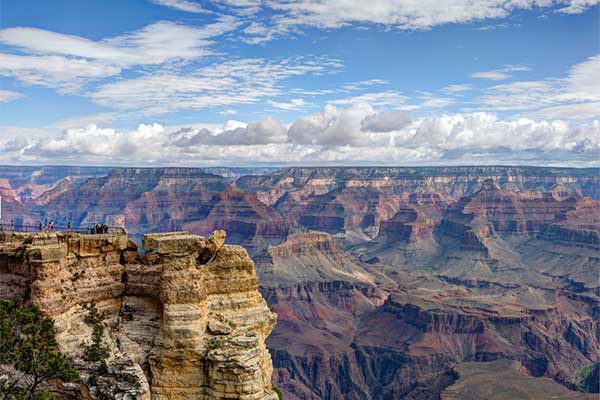
Grand Canyon Weather
The answer to the question “what is Grand Canyon weather like” depends on many factors. The canyon stretches 277 miles long, up to 18 miles wide and more than a mile (6,000 feet) deep. It has a semi-arid climate, with some sections of the upper plateau covered by forests and its bottom marked by a series of desert basins. The most highly visited areas of the Canyon include the South Rim, North Rim, and West Rim. Each one has its own distinctive weather that varies with the seasons.
While the National Park Service (NPS) posts general climate conditions of these areas on its website, you’ll want to get more precise info about the weather in the places you plan to visit by checking with the National Weather Service. Knowing the weather conditions for a specific area will help you decide whether you want to tent camp or stay at a lodge, what types of activities or tours you might enjoy, or even if you want to alter the timing of your route. It’ll also help you to choose which items to pack for your journey.
The Grand Canyon Makes Its Own Weather
The vastness of the Grand Canyon and its steep changes in elevation enable it to create its own weather! The canyon rises to an elevation of 8,000 feet on the North Rim and drops to 2,000 feet above sea level at Phantom Ranch. Sudden changes in elevation impact temperature and precipitation, so the weather can vary dramatically depending on your location and the time of the year that you visit.
The air currents and heat in the Canyon also affect the weather. Temperature inversions occasionally happen here, when a layer of warm air sits on top of cold air. This phenomenon gives rise to fog and pulls the clouds below the rim, making you feel as if you are standing on top of the world. It’s truly a spectacular sight with the canyon floating in a sea of clouds.
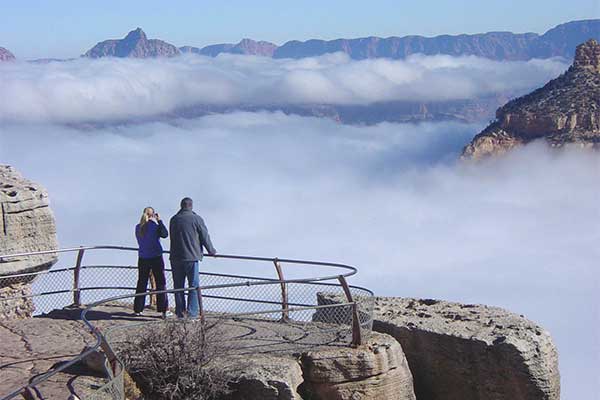
What Is the Best Time of Year to Visit the Grand Canyon?
The best time of the year to visit the Grand Canyon depends on your planned activities. Popular things to do in the area range from Jeep tours with amazing views to stargazing. Other activities include mule rides, hiking, camping, river rafting, horseback riding and even cross-country skiing in winter. Besides confirming weather conditions find out from the NPS if your chosen section is open during the time that you plan to visit.
Grand Canyon South Rim Weather
The Grand Canyon’s South Rim is its most visited section because of its amenities and relatively mild weather conditions. During the summer, you can expect average daytime temperatures to reach 85° and drop to 55°F at night. Winter weather at the South Rim is a little less predictable. According to the NPS, you could experience snow, icy trails and road closures during this time.
Grand Canyon North Rim Weather
Summer weather at the North Rim is nearly perfect. The jewel of the North Rim is the Grand Canyon Lodge—a mix of motels and cabins—and the only lodging inside the Grand Canyon National Park. You can expect average daytime temperatures to hover just under 80°F and lower to the mid-40s at bedtime. The North Rim is closed during winter.
Grand Canyon West Rim Weather
The Grand Canyon West Rim is located on the Hualapai Indian reservation and home of the Grand Canyon Skywalk. The area’s hot, dry summer weather is ideal for Colorado River rafting and floating. It is near the put-in for many of the Canyon’s river running expeditions. Early spring and late fall temperatures in the 70s and 80s make trips to the West Rim’s Skywalk glass bridge and other Native American tourist sites comfortable.
Grand Canyon Weather by Month
Temperatures throughout the Canyon can fluctuate greatly from month to month. Knowing the monthly weather patterns of the Grand Canyon’s South, North and West Rims helps you to plan a one-of-a-kind vacation to this famous landmark.
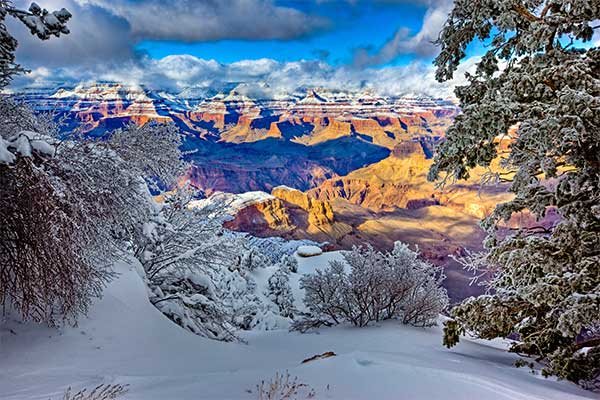
Grand Canyon Weather in January
At the South Rim, average daytime temperatures reach 40°F and lower into the teens during the evening in January. Harsh temperatures that range from 16°F to 37°F and snowfall prompt the NPS to close the North Rim to vehicles from December 1st to May 15th. You’ll experience average daytime temperatures in the mid-50s and evening temperatures in the mid-30s at the Grand Canyon’s West Rim.
Grand Canyon Weather in February
The weather in February brings average South Rim temperatures of 45°F during the day and 21°F at night. North Rim temperatures are between 39°F and 18°F. You’ll likely experience temperatures between 62°F and 42°F at the West Rim.
Weather in March
Grand Canyon weather in March brings a temperature range between 51°F and 25°F at the South Rim. The North Rim has temperatures between 44°F and 21°F. The West Rim, which has temperatures that are between 82°F and 56°F, is much warmer than the other two Grand Canyon sections. Wildflower season begins to bloom in mid-March and continues through May.
Weather in April
April offers excellent weather at the South Rim, which has temperatures between 60°F and 32°F. Grand Canyon weather in April brings the North Rim average temperatures between 53°F during the day and 29°F at night. At the West Rim, you’re likely to experience a balmy 82°F during the day and 56 °F at night.
Grand Canyon Weather in May
The weather in May delivers average daytime temperatures of 92°F and evening temperatures of 63°F to the South Rim. The North Rim opens for the season in mid-May, and it has average temperatures between 62°F and 34°F during this time. You’ll likely see temperatures rise to 92°F and drop to 63°F during May at the West Rim.
Weather in June
June brings temperatures between 81°F and 47°F to the South Rim. Mild temperatures that range from 73°F to 40°F will greet you during June at the North Rim. Grand Canyon weather in June presents the West Rim with daytime temperatures of 101°F and evening temperatures of 72°F. Mid-June also brings Arizona’s monsoon season to the Grand Canyon, which can produce strong winds, thunder, severe lightning and torrential rains. Flash flooding can occur in low-lying areas.
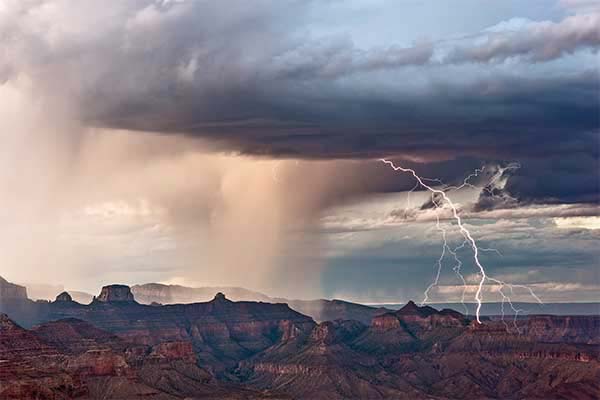
Grand Canyon Weather in July
The weather in July brings the hottest climate to the region, and you can expect South Rim temperatures to range from 84°F during the day to 54°F at night. Make the most of nice weather at the North Rim by enjoying temperatures between 77°F and 46°F. Be ready for daytime temperatures that reach 106°F and nightly temperatures of 78°F when you visit the West Rim in July.
Grand Canyon Weather in August
Grand Canyon weather in August attracts campers and hikers to the South Rim with daytime temperatures of 82°F and evening temperatures of 53°F. The North Rim has temperatures between 75°F and 45°F. The West Rim remains hot in August with temperatures between 103°F during the day and 75°F at night. August is the height of the monsoon season’s electrifying (and potentially dangerous) lightning shows.
Grand Canyon Weather in September
Grand Canyon weather in September brings temperatures between 76°F and 47°F to the South Rim. You’ll enjoy temperatures between 69°F and 39°F at the North Rim during September. The West Rim cools slightly in September with temperatures between 97°F during the day and 69°F at night. The summer monsoons end around mid-September and the days grow shorter, bathing the Canyon in gorgeous autumn light.
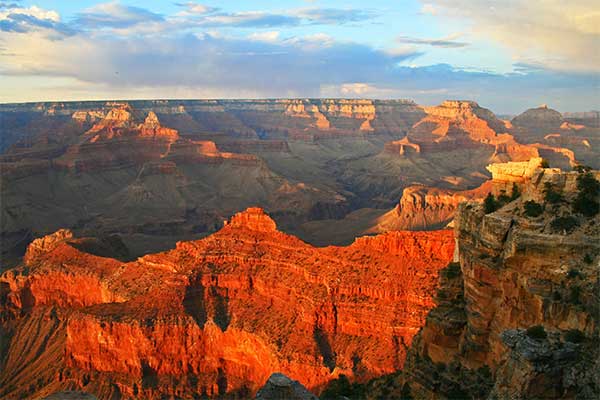
Grand Canyon Weather in October
In October, South Rim hikers and trail runners find great weather with temperatures between 65°F during the day and 36°F at evening. Grand Canyon weather in October marks the end of the season at the North Rim, with most visitor services and facilities closing in mid-October. During this time, North Rim daytime temperatures reach 59°F and plummet to 31°F at night. The North Rim is also one of Arizona’s best bets for fall colors. Prepare for a pleasant stay at the West Rim during October with temperatures that range from 84°F during the day to 58°F at night
Weather in November
November brings daytime temperatures of 52°F and evening temperatures of 27°F to the South Rim, making it one of the best times to hike to avoid summer crowds. The North Rim has temperatures of 46°F during the day and 24°F at night. The weather in November brings the West Rim daytime temperatures of 68°F and evening temperatures of 46°F.
Weather in December
Grand Canyon weather in December delivers daytime temperatures of 43°F and evening temperatures of 20°F at the South Rim. North Rim temperatures range from 40°F during the day to 20°F in the evening. The West Rim offers you daytime temperatures of 57°F and evening temperatures of 37°F, making it the Grand Canyon’s warmest rim year-round.
In Conclusion
Grand Canyon weather conditions can make or break your vacation plans. Preparing for all types of atmospheric conditions helps to ensure your group’s safety and well-being when traveling through rugged destinations. Pink Jeep operates year-round tours at the Grand Canyon departing from Sedona, Las Vegas and in Tusayan.